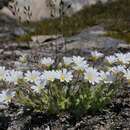Associations
provided by BioImages, the virtual fieldguide, UK
In Great Britain and/or Ireland:
Foodplant / parasite
sporangium of Peronospora conferta parasitises live Cerastium alpinum
Other: unusual host/prey
Comments
provided by eFloras
The
Cerastium alpinum group of species is a difficult complex of intergrading taxa. E. Hultén (1956) considered this complex to be the result of worldwide introgression among the various taxa. Members of this group in North America include
C. aleuticum,
C. alpinum,
C. arcticum,
C. beeringianum,
C. bialynickii,
C. fischerianum,
C. regelii, and
C. terrae-novae.
Cerastium alpinum itself is distinguished from all other members of the complex by its lanate pubescence, which consists of long, silvery, translucent, multicellular, flexuous, often tangled hairs; the more or less square base of the calyx; the convex margins of the sepals; and, in well-grown plants, the long, slender, divaricate pedicels.
In western North America, Cerastium alpinum is replaced by C. beeringianum, which has long, straight, strigose, somewhat fuscous hairs, usually smaller flowers, and smaller seeds. The two species intergrade in eastern Canada; intermediate specimens were named C. alpinum var. strigosum Hultén.
Cerastium arcticum differs from C. alpinum, with which it often grows, in its straight, somewhat fuscous hairs; calyx which is round at the base; long, narrowly lanceolate sepals; large, straight, broad capsules; and broad, obtuse cauline leaves. Like C. alpinum, it usually has large flowers with the petals much longer than the sepals.
Many infraspecific taxa have been named in Cerastium alpinum but in North America it is much less variable than elsewhere. Two forms can be recognized at either the varietal or subspecific level.
- license
- cc-by-nc-sa-3.0
- copyright
- Missouri Botanical Garden, 4344 Shaw Boulevard, St. Louis, MO, 63110 USA
Description
provided by eFloras
Plants perennial, mat-forming, rhizomatous. Stems prostrate or ascending, tomentose (very rarely subglabrous), hairs white, trans-lucent, long, soft, flexuous, some usually also short and glandular; flowering shoots ascending, 5-20 cm; small axillary tufts of leaves usually absent; nonflowering shoots ± prostrate, to 6 cm. Leaves marcescent or not, sessile; blade obovate or ovate to elliptic-oblanceolate, elliptic, or lanceolate, usually 10-18 × 5-7 mm, apex obtuse, pubescence as on stems. Inflorescences open, (1-)2-4-flowered cymes; bracts lanceolate, acute, margins narrow, scarious, glandular-pubescent. Pedicels straight but often becoming angled at base and curved at apex, slender, 5-30 mm, often elongating to 3 or 4 times as long as sepals, pubescence usually dense, hairs both long, flexuous, multicellular, and short, glandular, viscid. Flowers: sepals green, often violet tipped, narrowly elliptic-lanceolate, 7.5-10 mm, margins ± narrow, apex acute to obtuse, densely pubescent, hairs both long, eglandular and short, glandular; petals 1-2 times as long as sepals, apex shallowly 2-fid; stamens 10; styles 5. Capsules cylindric, slightly curved, 12-16 mm, to 2 times as long as sepals; teeth 10, erect, margins convolute. Seeds dark brown, 1-1.4 mm diam., acutely tuberculate; testa not inflated. 2n = 72, 108.
- license
- cc-by-nc-sa-3.0
- copyright
- Missouri Botanical Garden, 4344 Shaw Boulevard, St. Louis, MO, 63110 USA
Cerastium alpinum: Brief Summary
provided by wikipedia EN
Cerastium alpinum, commonly called alpine mouse-ear or alpine chickweed, is a mat-forming perennial plant. The species was first described by Carl Linnaeus in 1753. It is native to Greenland, Canada and northern Europe. It is grown as a rock garden subject for its many small white flowers and silver haired stems and foliage. There are three subspecies.
- license
- cc-by-sa-3.0
- copyright
- Wikipedia authors and editors

